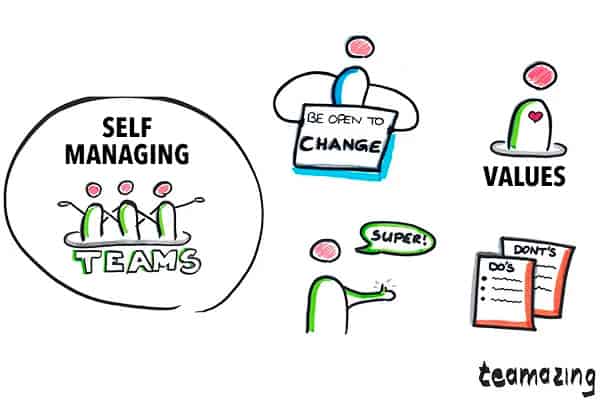Management tools are techniques or means used by managers to influence their employees. Managers bear a great responsibility and have a great influence on their teams. It is their task to control the work processes in a company. To ensure that this influence also has a positive effect on the company’s success, managers use so-called leadership tools. They have both direct and indirect management tools at their disposal. We will introduce you to both variants.
Management Tools: Definition
Management tools are tools used by managers to direct and manage their teams or organizations. These tools can include a variety of methods and techniques, such as goal setting, employee development, performance management, communication, delegation of responsibility, motivation, and conflict management.
For example, one leadership tool might be conducting regular performance reviews or feedback sessions to encourage and improve employee performance and engagement (see also: 360 degree feedback). Another tool could be a goal-setting process in which clear goals and metrics are set for the team or organization to measure and track progress. Important: Which management tools are used depends closely on the particular leadership style.
There are many different leadership tools and techniques that leaders can apply in different situations to effectively lead their teams and guide them to success.
Management Tools: Examples
Direct leadership tools are tools that managers use to directly influence and lead their employees. These tools may include, for example, regular performance reviews or feedback sessions to discuss employee performance and engagement. Setting clear goals and metrics to measure and track the progress of the team or organization is also a direct leadership tool.
Give feedback!
Feedback is the key to influencing the performance of your employees, making it a very important leadership tool. Feedback conversations are an important part of employee development and allow managers to evaluate and improve the performance and engagement of their employees.
Regular feedback sessions allow managers to track the progress of their employees and provide them with constructive feedback. These conversations provide both an opportunity to recognize positive performance and to identify areas for improvement. By communicating clear goals and expectations to their employees and monitoring their progress, managers can ensure that their employees are focused on the organization’s priorities and improving their skills and competencies.
Praise and appreciation
Through regular praise and appreciation, managers can create a positive working environment and strengthen the self-esteem of their employees. Employees who feel appreciated and recognized are generally more satisfied, more motivated and tend to perform better (read also: Fun job motivation quotes). So by regularly praising and appreciating their employees, managers can increase their commitment and motivation and thus contribute to the success of the team or organization.
Another important function of praise and appreciation is to strengthen employee loyalty. By recognizing and valuing their employees’ achievements, managers can gain their trust and loyalty. Employees who feel valued and supported by their managers are more likely to commit to the company for the long term and contribute to the success of the team or the organization (read more about the power of Praise here).

Creating trust
Trust forms the basis of every successful relationship, especially in a work environment. When employees trust their managers, they feel safe and supported. This promotes open communication and collaboration within the team, as employees are willing to share their ideas and concerns and give constructive feedback. Leaders who create trust thus have a direct impact on the work culture and work climate within the team or organization.
But how can managers create trust? One way is to communicate openly and transparently, and to keep promises. If managers inform their employees about decisions, changes and challenges and keep their promises, they can gain the trust of their employees.
Participation in decisions
By involving employees in important decision-making processes, trust in managers is significantly strengthened. Employees feel heard and respected, which makes them identify more strongly with the company and its goals. This in turn can have a positive impact on their motivation and performance.
In addition, employees can often bring useful perspectives and ideas that managers might not have considered on their own. A team of employees involved in decision-making can also lead to better decisions because it is viewed from different points of view and potential mistakes or blind spots can be revealed.
Transfer of individual tasks
There is always a lot to do in a company. Many of the important tasks often fall directly to the managers. So why not divide up tasks? Assigning responsibility allows employees to improve their skills and abilities and to develop personally. It gives them the opportunity to leverage their strengths and improve their weaknesses. In this way, they can be better positioned in the future to take on more responsibility or even reach higher positions in the company.
Managers themselves also benefit from this management tool. They are relieved and have time for other important tasks. By delegating responsibility to their employees, managers can focus on their own strengths and the strategic direction of the company. In doing so, managers should ensure that their employees have the necessary skills and resources to complete the tasks successfully and give them clear instructions and expectations.
Promotion and development of individual employees
The promotion and development of employees is an important management tool, as it not only advances the individual, but also the company as a whole. By providing their employees with targeted support and further training, managers can exploit their potential and develop important talents. This contributes to higher employee satisfaction and motivation and strengthens commitment throughout the company.
This can also make a positive contribution to retaining skilled workers in the company and avoiding a high fluctuation. Employees who feel that they can develop within the company and thus do valuable work are more likely to remain loyal to the company and make a long-term commitment. By specifically promoting certain competencies among their employees, managers can ensure that the company remains competitive in the long term and can adapt to constantly changing market conditions.
Indirect Management Tools
Indirect management tools do not have a direct impact on employees. In contrast to direct management instruments such as instructions, orders or controls, which have a direct impact on employees, indirect management instruments aim to influence the behavior and attitudes of employees in the long term and sustainably. Indirect leadership instruments therefore create a working environment which has a positive impact on individual employees.
Design of the working environment
The design of the work environment is an effective leadership tool because it has a direct influence on employees’ job satisfaction and motivation. A pleasant and supportive work environment can help employees feel comfortable and appreciated, and thus do their work better.
This includes, for example, the creation of a pleasant working atmosphere through appealing furnishings and decoration, but also through the establishment of routines such as regular team meetings or joint activities. In addition, a flexible work schedule or the possibility to work remotely can also contribute to increasing job satisfaction (see also: Leading Remote Teams).
Selection of personnel
By paying attention to the values and culture of the company, managers can ensure that new employees fit well into the team and create a positive work environment. The right attitude and motivation are important factors that should be considered in recruitment to ensure that new employees actually move the company forward.
A bad attitude or inappropriate behavior of an employee can lead to a deterioration of the working climate and even to conflicts within the team. By ensuring that they hire only qualified and appropriate workers, managers can ensure that the company remains successful and creates a positive work environment.
Creating incentives and control systems
Incentives and control systems are important management tools because they can motivate employees to do their jobs better. Incentives can be monetary or non-monetary and include, for example, bonuses, promotions, or praise and recognition. Incentives can help employees identify more with their company and their work and increase their willingness to perform.
Control systems, on the other hand, are used to monitor and manage employee performance and behavior. Clear targets, regular feedback discussions and performance evaluations can motivate employees to improve their performance and continuously develop. Control systems also help to identify bad behavior at an early stage and to counteract it in a targeted manner.
Establish clear rules
Establishing clear rules can be an effective management tool, as it creates a clear orientation for employees and thus reduces uncertainty and conflicts. With clear rules and processes in place, people can make decisions faster and do their jobs more effectively because they know what is expected of them. In addition, this can help to create a sense of fairness and justice in the company, as all employees are treated according to the same rules and criteria.
If rules are not clear or are not in place, employees may feel that decisions are made arbitrarily or that they are in an uncertain work environment. This can have a negative impact on their motivation and their work. However, when clear rules and processes are in place, employees can focus on their work and feel confident that their work will be recognized if they follow these rules.
Tools and Rules
Having shared values in the company will make it a lot easier for you to create overarching rules. However, setting these values for everyone is easier said than done. With our Workshop on Values and Rules, we help you reach a common denominator with your team.
Team development: team events, team building etc.
Team development is an important leadership tool, as it can help to strengthen cooperation and cohesion within a team. Through team events or team building measures, employees can communicate better with each other, resolve conflicts and support each other. A strong team feeling can also increase employee motivation and lead to higher productivity.
In addition, team development can also help employees develop a shared vision and goals for the team. When everyone on the team shares the same goal, it can contribute to a more effective and more efficient way of working. For perfect team development, we recommend our in-depth guide.
By participating in team building activities, managers can also get to know their employees better and assess their strengths and weaknesses. This enables them to better address the individual needs and abilities of their employees and to provide them with targeted support.
Modern Management Tools
- Agile methods: Agile methods are a modern type of project management methodology that focuses on flexibility and rapid adaptation to change. One example is the Scrum method, in which teams work in short iterations (sprints) and incorporate regular feedback loops. These methods can help increase employee engagement and creativity. Our Software-Driven Teambuilding stream has recently been making use of the SCRUM method, and is thrilled with the results so far.
- Positive Leadership: Positive leadership is an approach that focuses on bringing positive emotions and motivation to the forefront to improve employee performance and well-being. This involves leaders building on the strengths and successes of their employees and using positive reinforcement to enhance their performance.
- Design Thinking: Design Thinking is an approach that involves finding innovative solutions through creative thinking and collaboration. It is a method often used in the development of new products or services, but can also be applied to problem-solving within a company.
- Mentoring and Coaching: Mentoring and coaching are management tools that focus on supporting the development and growth of employees. Through targeted training, feedback, and guidance, employees can better realize their potential and develop their skills.
- Social collaboration tools: Social collaboration tools enable virtual teams to collaborate online and share knowledge and ideas. They are platforms that enable seamless collaboration between employees, departments and locations. One example is Microsoft Teams, which offers a combination of chat, online meetings, file sharing and real-time collaboration (we use a tool called Gather.town)
- Data Analytics: Data analytics is an approach that uses data to gain insights and make decisions. It can help measure and improve the performance of employees, departments, or the entire organization. By analyzing data, managers can make informed decisions and identify potential problems early.
- Situational leadership: Situational leadership allows you to adapt your leadership style to the current situation. This allows you to be more agile and flexible in responding to problems and obstacles.
Conclusion
Management tools play a critical role in creating a productive work environment and achieving organizational goals. The right management tools enable leaders to exert positive influence on their teams, improve communication, and align organizational efforts toward common goals. By adapting to different situations and incorporating feedback, appreciation, trust-building, and participation in decision-making, leadership tools can boost team morale and pave the way for continuous improvement and sustained success. In this way, they help foster a culture of engagement and innovation that drives the organization’s development.







